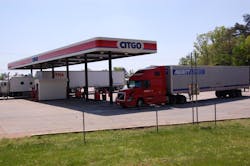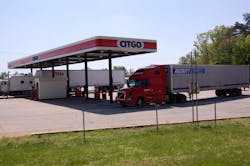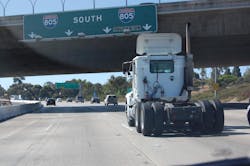While local fuel taxes aren’t necessarily new – indeed, Nevada’s Washoe County passed a similar fuel tax hike on diesel back in 2009, and we’ll get to that in a bit here – trucking’s involvement in crafting Clark County’s fuel tax plan certainly is, and the industry did so in an effort to head off some very nasty ripple effects.
Thus, as more and more local governments potentially line up to institute such localized fuel taxation, truckers may want to keep Nevada’s experience with such taxes handy.
First, let’s examine Clark County’s fuel tax plan more closely. First of all, it’s a county ordinance that indexes the fuel tax to inflation; a move that is expected to result in that 3-cent per gallon tax increase mentioned earlier.That fuel tax boost will, in turn, allow the Regional Transportation Commission of Southern Nevada (RTC) to issue bonds to fund 183 regional transportation projects, including developing Interstate 11, widening U.S.-95 in the northwest part of Las Vegas from Ann Road to Kyle Canyon, bringing the 215 Beltway to freeway standards, among others.
Here’s another key part of this tax plan: all of the funds generated by Clark County’s fuel tax hike will only go toward projects in Clark County.
Now, without indexing, RTC estimated that it would only have about $22.4 million per year over the next 10 years to spend on local streets and highway projects – equivalent to building one interchange per year, one mile of roadway per jurisdiction per year, or one beltway segment without bridges per year.
“Figuring out how best to raise revenue to fund roadway projects is an issue that not only affects Clark County but our entire nation,” noted Tina Quigley, RTC’s general manager, in a statement. “We believe that indexing the fuel tax to inflation is the quickest alternative with the least impact on our community to help address our streets and highways budget that will allow us to help create a transportation vision for our future.”
That’s all very nice, but Nevada’s truckers quickly realized that such localized fuel taxes don’t count towards International Fuel Tax Agreement or “IFTA” calculations – and that leaves carriers both large and small open to “double taxation,” Paul Enos, executive director of the Nevada Trucking Association, told me.
Now, as all truckers know, IFTA is a compact signed by the 48 contiguous states and 10 Canadian provinces to ensure that fuel taxes are paid not at the point of purchase (where a truck fills up on fuel) but at point of use. “This ensures that interstate trucking companies that travel on Nevada’s roads are paying for their use on Nevada’s roads, even if they do not buy fuel in our state,” Enos explained.
Thus every interstate trucking company is required to keep track of their miles traveled in every jurisdiction, and report those miles traveled to their base state, which then sends the revenue due to other states. If a carrier owes more to a particular state, Enos said, they send in a tax payment. If the carrier has paid too much they receive a refund.Ah, but here’s the critical part: IFTA only deals with state taxes and will not collect, or credit, local taxes unless they are applied statewide.
Now, with that salient fact in mind, let’s return to Nevada’s Washoe County, which implemented an “indexed to inflation” fuel tax hike four years ago.
Enos explained that Washoe’s fuel tax hike initially started at 3 cents per gallon but has increased by about 3 cents per gallon every year since – and none of it counts towards IFTA calculations.
As an example of how that hurts truckers he pointed to Washoe-based carriers that operate a goodly portion of miles in nearby California. The Golden State imposes a fuel tax of 44.5 cents per gallon, whereas Nevada’s state fuel 27 cents per gallon. Ah, but truckers in Washoe County pay a further local fuel tax of 13.5 cents per gallon, meaning they are shelling out about 40.5 cents per gallon in total state and local fuel taxes. Yet that extra 13.5 cents per gallon doesn’t count towards their IFTA payments.
End result? Although Washoe County-based truckers actually pay 40.5 cents per gallon in fuel taxes, they only get assessed the difference between the California state rate of 44.5 cents and the Nevada state rate of 27 cents per gallon. This effectively is double taxation on the California miles because instead of having to make up only 4 cents per gallon in fuel tax differences between Nevada and California, Washoe truckers must make up 17.5 cents per gallon.
Enos told me that, for one Washoe County-based trucking firm that operates 80% of its miles in California, that translates into $120,000 in extra fuel tax payments to the Golden State per year. In a word: blech!
“On top of all that, the Washoe County fuel tax plan can’t be changed until 2019 until the bonds it’s indexed against come due,” Enos told me. “That’s why we got involved in the Clark County fuel tax effort: we wanted to ensure more Nevada trucking companies don’t become competitively disadvantaged due to higher fuel taxes.”
In Clark County’s case, then, the trucking community crafted a fuel tax rebate structure similar to IFTA’s and managed by Nevada’s department of motor vehicles (DMV). Enos explained that having a single state entity collect and manage and collect such local fuel taxes – DMV does the same for Washoe County – is critical as it significantly reduces administrative costs, thus ensuing more tax money ends up funding transportation projects.
Enos also believes that the trucking community should prepare itself for more “localized fuel tax hikes” as they are the wave of the future to his mind.
“No one wants to raise taxes; not the federal government, not the state legislatures,” he explained. “In our case in Clark County, the state legislature designed this fuel tax, allowed for DMV to collect and manage it, yet then pushed the final decision to implement it down to the board of commissioners.”
Enos also said Nevada’s trucking industry saw this coming for a while and realized it would be very difficult – if not impossible – to stop. “So we said how do we get involved to ensure our industry doesn’t suffer competitively from this? I hate to be a trailblazer – it certainly isn’t fun – but we had to face the reality of this [Clark County fuel tax] and make the best of it,” he said. “Given that it mirrors the current structure of IFTA, it’s a system that’s as fair as can be.”
Now we must wait and see how many other localities follow Nevada’s example, crafting fuel taxes to pay for local transportation projects.



